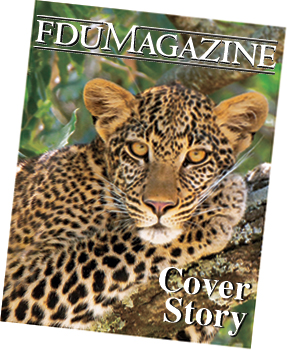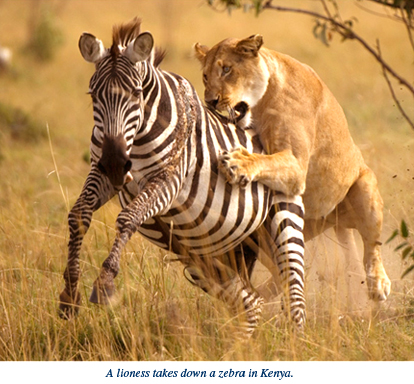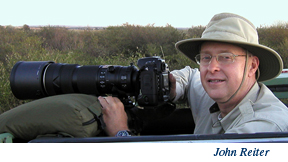
“Can you imagine being surrounded by giant gorillas with eight-foot-wide arm spans … and they’re brushing right past you while you shoot photographs?” |
|---|

Globe-
trotting for Big GameHe says he’ll never forget that “incredible moment” when he first went eyeball-to-eyeball with a powerful, chestthumping, 600-pound Silverback Gorilla.
It happened early one drizzly morning in November 2005, after professional photographer John Reiter, BS’70 (T), had spent several hours hacking his way through a dense bamboo rainforest in the mountain jungles of Rwanda. Armed with nothing more powerful than a Nikon D2X digital camera and a tripod, the intrepid Reiter looked up from his photo gear and discovered that he was crouching less than 20 feet from a large family of cavorting gorillas.
What followed was an unforgettable, hour-long photo shoot with some of nature’s most awesome jungle creatures.
“It took me and my guide nearly three hours to climb up the side of a 10,000-foot-high volcanic mountain,” says Reiter, a former FDU marketing major who’s been taking nature photos for more than 35 years, “but the struggle to reach these animals was worth every minute. Can you imagine being surrounded by giant gorillas with eight-foot-wide arm spans … and they’re brushing right past you while you shoot photographs?

“They’re beating on their chests, and it sounds like thunder while the babies play at your feet. They’re snapping bamboo shoots in half like they’re matchsticks. Before we got there, my guide had explained that adult gorillas are as strong as five or six grown men — and that they could kill you quite easily, if they wanted to.
“And yet they aren’t by nature aggressive — not unless you touch or approach one of their babies, that is. I felt no fear as I took their pictures. I call these mountain gorillas the ‘Gentle Giants of Rwanda,’ and photographing them in their natural habitat was one of the most thrilling experiences of my life.”
An adrenalin-charged moment? You bet. But the mountain gorillas of central Africa aren’t the only creatures that fascinate the globetrotting Reiter, who retired five years ago after 31 years as a marketing executive for computer services giant Automated Data Processing and then launched a commercial enterprise as a photographer (see www.johnreiterphoto.com). Reiter, who has won several national and regional awards for his nature photos in recent years, has pursued not only lions, elephants, leopards and many other “big game” animals in Africa … but also dazzling swarms of Monarch butterflies in California, vividly hued flowers such as Bluebonnets and Indian Paintbrush in Texas and a wide variety of colorful woodland creatures and landscapes in Hawaii and the Canadian Rockies.
“I’m having a wonderful time with my camera these days, … I’m living proof that retirement can be a great experience, if you plan it so that you can spend your time doing something you love.” |
|---|

“Searching for wild animals in the bush is what I would call the ‘ultimate photographic adventure,’ and I really love the challenge of struggling across difficult terrain in order to capture an unforgettable photo of a lion bringing down a zebra, or an elephant running at full speed across a jungle clearing.” A New Jersey native who grew up working weekends on his family’s apple orchard in Mahwah and still lives there, Reiter says, “Searching for wild animals in the bush is what I would call the ‘ultimate photographic adventure,’ and I really love the challenge of struggling across difficult terrain in order to capture an unforgettable photo of a lion bringing down a zebra, or an elephant running at full speed across a jungle clearing.
“But I also enjoy taking pictures of flowers right in my own backyard. For me, taking photos is all about learning how to see.” Reiter,
who can be reached at NJPhotoguy2@aol.com, teaches photography part-time. “I tell my students that the first step in learning how to be a photographer is to start looking hard at what’s right under your nose!”Reiter says he first began to learn that lesson at FDU. One day, a particularly insightful English instructor walked into his literature class and — without explanation — suddenly began reciting William Wordsworth’s famous poem “The World Is Too Much with Us,” which focuses on the modern world’s increasing inability to connect with nature:
The world is too much with us;
late and soon,
Getting and spending, we lay waste
our powers;
Little we see in Nature that is ours;
We have given our hearts away. …“That was a freshman English class, and it took place so long ago that I can’t even remember the professor’s name,” says Reiter. “But his point stuck with me, and so I’ve done my best throughout the years to stay in touch with the natural world.”
The father of three grown sons, Reiter says he planned his business career very carefully — so that he would be assured, after retiring at age 53, of having some years in which to wander the globe in search of exciting images of nature.
In March, Reiter took a weeklong expedition on Alaska’s remote Kenai Peninsula, during which he took hundreds of color photos of iconic American bald eagles.
“The eagles gather on the frozen surface of Kachemak Bay each winter in search of food,” says Reiter, who endured zero-degree temperatures for hours at a stretch in order to capture the majestic birds on film. “They start landing at dawn on the ice and you have to be in position and ready to shoot your photos when they arrive, because if you start moving around, you’ll frighten them off.
“This is the largest concentration of bald eagles in Alaska, and it’s an amazing show. On the morning I spent there, at least a hundred of them gathered on the ice.”

Located more than 225 miles south of Anchorage, the eagle feeding ground is so remote that Reiter was required to catch rides on two different “float planes” as he made his way to the spectacle. But he says the journey was “worth every minute” because it brought him into close contact with dozens of the soaring birds — “incredibly regal-looking creatures” whose wingspans can reach eight feet.
In spite of the physical risks posed by the Alaskan wilds, however, Reiter plans to be back in the nation’s largest state by the time this goes to press, this time to photograph the famed salmon-chasing grizzly bears at Katmai National Park.
“I’m having a wonderful time with my camera these days,” he describes when asked about his life as a retired citizen. “I’m living proof that retirement can be a great experience, if you plan it so that you can spend your time doing something you love.”
— T.N.
FDU Magazine Home | Table of Contents | FDU Home | Alumni Home | Comments
©Copyright 2007 Fairleigh Dickinson University. All rights reserved.
For a print copy of FDU Magazine, featuring this and other stories, contact Rebecca Maxon, editor,
201-692-7024 or maxon@fdu.edu.
